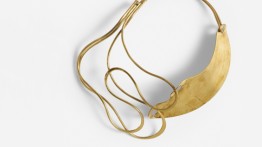COOPERMADE: Post-War Biomorphic Design

Art Smith A'40 brought the biomorphic forms so popular in midcentury modern furniture and textile design to jewelry. Famed for their sinuous, curved, and organic designs, his cuffs, necklaces, and pendants have been celebrated in Vogue and Harper’s Bazaar, and collected by Duke Ellington and Eleanor Roosevelt, among others.
Born in Cuba to Jamaican parents, Smith grew up in Brooklyn and began his studies at The Cooper Union with the intention of becoming an architect, though he soon redirected his interest in three-dimensional space to sculpture. He learned to make jewelry at NYU and the Children’s Aid Society where he served as a crafts supervisor. Deeply influenced by an apprenticeship with the jewelry designer Winifred Mason (believed to be the first commercial Black jeweler in the United States), he opened his own studio in 1946. The shop, which he eventually moved to West 4th Street in Greenwich Village to escape the racism and homophobia of its original location, featured daring and playful work that interpreted art movements with much currency during the post-war era—surrealism, primitivism, and organicism.
According to the Cooper Hewitt, which holds almost a dozen of Smith’s works, “he considered his jewelry as an incomplete sculptural expression until it was related to the body.” He began designing for the company of avant-garde dancer Tally Beatty, who introduced him to some of the city’s most influential Black intellectuals and performers including James Baldwin, Billy Strayhorn, and Lena Horne.
His jewelry, usually made from copper, silver, or brass, grew in popularity among collectors as he began to sell pieces in high-end department stores like Bloomingdale’s. Today his work can be found in the Museum of Modern Art, and many other collections. Smith has been the subject of numerous retrospectives including “From the Village to Vogue” at the Brooklyn Museum in 2008.





